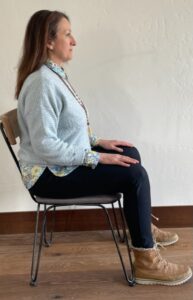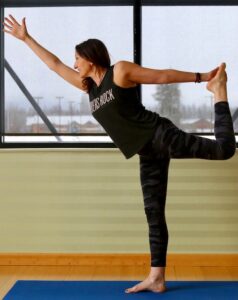By Debbie Burke
Disclaimer: nothing is this article should be construed as medical advice.
Writing can harm the body. Okay, it’s not as bad as logging, or bull riding, or bomb dismantling. But sitting all day hunched over a computer is not a healthy lifestyle.
 Recently I had an enlightening conversation with a chiropractor, Dr. Erika Putnam, shown here consulting with her office manager, Hartty.
Recently I had an enlightening conversation with a chiropractor, Dr. Erika Putnam, shown here consulting with her office manager, Hartty.
Dr. Erika has unique insight into the particular physical problems that beset our profession because she herself is a writer. In addition to her chiropractic practice and operating a yoga studio, she contributed to the Ultimate Guide to Self-Healing Volumes 1-5. She is also working on her memoir and a how-to manual for yoga instructors.
So…I asked her for tips specifically to help writers.
Her overall approach is to develop a “long-term vision of our health and career path.” She says, “Value your wellbeing and work toward preserving that. Think prevention rather than fixing damage.” She believes for optimal health, humans need fresh air, sunshine, the earth…and time away from staring at electronic devices.
People who spend long hours sitting at a computer tend to develop tight chests, tight hip flexors, and are weak in the core and the butt.
What can we do about that?
Here are Dr. Erika’s 10 tips:
- Undo what you do. If you use muscles in the front of the body, you need to counteract by using muscles in the back. Below is a good exercise to undo writer’s slump.

2. Strive for anatomical neutral: This means good posture with shoulders back, head up, chest up, arms at your sides with hands extended. For yoga aficionados, this is similar to mountain pose.
3. Neck care: a head-forward posture is hard on the neck. The farther forward your head is, the more strain on your neck. Sit straight with your head in line with your shoulders and pull your head and chin back. Try the old balance-a-book-on-your-head trick.
4. More Neck Care: At least once an hour, turn your head from side to side, looking over your shoulders.
5. Breathing: When shoulders curl forward, breathing becomes shallow. Take deeper breaths to improve posture. Stretch arms over your head to move/open the ribs to allow deeper breathing. Repeat several times/hour.
6. Neutral spine: When seated, rock your pelvis to find the correct neutral spine posture.
7. Sitting posture: If you sit on the back of the “sit bones,” pressure on the pelvis over time wears out disks in the spine.
Instead, sit up on sit bones. A pillow behind your back may help.
8. Hand care: Typing uses finger flexion which tends to curl hands into claws. To counteract, open your hands, stretch fingers, and press palms together.
9. Get up and move around at least once an hour. Take a walk. Do stretches. Dr. Erika suggests: “Go outside and play with dirt.”
10. I’ll take credit for this tip which came about after my visit with Dr. Erika.
After spending an hour with her, I became much more aware of my posture, standing straighter, shoulders back, chest up, head up. When I got into my car to leave, I noticed the rearview mirror was tilted too low. It had seemed fine while driving to her office. But, after an hour of consciously improving my posture, I realized I now sat a couple of inches taller in the seat. I needed to adjust the mirror upward.
I decided to leave the mirror in the higher position as a reminder to sit up straight.
The more reminders the better.


One final note: Dr. Erika says she can’t back up the following observation with scientific studies but she has frequently noticed that people with a right-side head tilt often have a great deal of left-brain activity.
Here’s a discussion of right brain/left brain from Medical News Today.
JUST FOR FUN — Here’s a totally unscientific experiment to try:
If you’re having problems with plot organization, see what happens if you tilt your head to the right. Does that activate your left (analytical) brain?
If your story needs more feeling, trying tilting your head to the left. Does that activate your intuition and emotion?
Does head tilting make any difference in your thinking process? Please share your results in the comments.
~~~
TKZers: What helps keep your writer’s body in good condition? Do you have favorite exercises?

A special thank you to Connie Cermak for the photos in this post.
But sitting all day hunched over a computer is not a healthy lifestyle.
Something that made a huge difference for my neck and back was making sure my monitor was at eye level. I use a laptop and was looking down when at my desk. I got a stand to raise it to eye level and some neck/back probs went away.
This stuff is important. Thanks Deb and Dr. Erika for the tips.
What a great, simple solution, Jim. I’ll try that.
Thank you, Debbie and Dr. Erika ( and a tip of the fedora to Jim as well). This stuff is gold. It’s easy to implement and makes an immediate difference.
You’re welcome, Joe. We need all the help we can get.
Thanks for this. I have a good ergonomic chair, but I need to work on neck positions. You can hear the crunching across the room.
Terry, you reminded me of the old Rice Krispies commercial: “Snap, crackle, pop!”
Ten top tips for sure, Debbie. Thanks! They (whoever they is) say sitting is the new smoking. I always take a break at the +\- 50 minute mark and get up and move around for about 10 minutes. A few years back I bought a table-top stand-up desk. I don’t care for typing while standing but it’s a great rabbit hole position. And there’s nothing like good ole fresh air. I do a 3 mile walk daily. Speaking of days, enjoy your day!
Garry, in a 2018 post, I mentioned sitting as the new smoking, along with a condition called “Dead Butt Syndrome”! http://killzoneblog.com/2018/01/five-new-years-tips-to-overcome-butt-in.html
Have a great, productive day!
Great post, Debbie. I like #9 – “Go outside and play with dirt.” Besides range-of-motion and undoing the damage of long hours sitting at the computer, that “playing” helps strengthen muscles that have been resting. And, as Kay mentioned yesterday, that physical exertion is good for creativity. Keep the ear buds out and listen to nature. Set the creative juices free.
Thanks, Steve. Playing with dirt during gardening season is one of my favorite plotting tools. The grubbier I get, the better the ideas. Nature does have healing power.
Great tips. Thank you. I’m so glad that in the last week or two we’ve had multiple posts/comments that focus on health for writers. It’s something we can too easily ignore in the rush of the day with our busy schedules.
Maybe we need to add to that phrase–instead of just carpe typem it should be carpe typem/go walkem. LOL!
Let’s keep taking care of our bodies so we can keep putting out those stories! 😎
“Carpe typem/go walkem” definitely! Love the phrase, BK.
Great tips, Debbie. My physical therapist gave me a McKenzie lumbar pillow. It works as long as I sit back in my chair. But the more I focus on the screen, the more I scoot forward, and I have to keep reminding myself to sit back. Hence why I now have to stop every 25 minutes to walk around.
Fascinating about the neck tilt. As I read it, I noticed I was tilted to the right. Which makes sense since I’m working on nonfiction today. I’ll have to check tomorrow when I switch back to fiction. 😉
Thanks for the lead on the lumbar pillow, Sue. I’ll check that out.
Time for a walk break!
Great tips, Debbie! Thanks for posting these. I’ll be sharing them with my writer’s group. I’m a big yoga fan, and also a fan of getting up and walking around for a few minutes at the 30-50 minute mark. It’s very helpful to have some targeted poses to do on a break, and these fit that bill very nicely.
My laptop is plugged into a desktop monitor, which is at eye-level for me (the laptop is on a pull out keyboard drawer of my computer hutch).
Have a great day!
You’re so welcome, Dale.
I used to enjoy yoga but b/c of “after-market replacement parts”, it’s no longer doable. But some of the fittest people I know stay that way b/c of yoga.
Good day to you too!
Writer Debbie Burke,
Your article is a great reminder to strive for prevention rather than fixation. I’ve spent thousands of dollars repairing my neck and back from poor writing habits, i.e. writing in bed, texting with my head down. Thanks for the share and to Dr. Erika Putnam for her knowledge.
Sue, your painful experience spawned the idea for this story. Thanks for introducing me to Dr. Erika!
Great tips! Thank you Debbie and Dr. Erika. I can relate to tight hip flexors from sitting for a long time.
I do most of my laptop work at my desk, but I use my recliner with my laptop on a little lap stand when I’m writing. It provides me with support all the way up my spine that I think is good. I’d be interested to know what Dr. Erika thinks of that posture.
Head tilting! You may have found a new solution for writer’s block!
You’re welcome, Kay.
Hmm, how ’bout a variation on #4–the neck turning side to side. Add in tilting side to side!
I hear Rice Krispies in my neck–needs more work.
Sometimes the bad in life can be good. i have fibromyalgia and scoliosis so I can’t sit for any periods of time, which means I do A LOT of walking and moving around. I also have to be very faithful with stretching and mindful of posture while sitting. In some ways, I’m healthier than my “normal” friends.
My chiro has a poster in his therapy room. I read it every time I visit. It’s a quote by Thomas Edison: “The doctor of the future will give no medication but will interest his patients in the care of the human frame, diet and in the cause and prevention of disease.” Mr. Edison knew more than just about light bulbs.
Laurie, how wise of you to make lemonade out of lemons. Thanks for the great Edison quote, too!
All that is very true. Very good advice. Back trouble and carpal tunnel damage are our professional physical injuries. I’ve dealt with a damaged back, courtesy of being below average in height in a world built for average people for forty years, and the gym and walking have kept me going.
Marilynn, my medical insurance pays for a gym membership which is a smart way to head off future problems. Consistency is key…just like writing!
What a clever blog — and a useful one. I bought a stand to raise my computer on my desk. My neck often hurts at the end of a working day. Dampen a towel and heat it in the microwave for 45 seconds — instant relief.
Great hint about the damp towel in the microwave, Elaine. I’m a big fan of simple, inexpensive hints like that.
Debbie: Thanks for the opportunity to share. Looks like you sparked some more great ideas. Hooray for healthy posture! And, hooray for more words on the page!
Hi Erika, thanks for sharing your experience at TKZ. You helped a number of writers today!
I notice when I am in the zone. I hardly move and then when the spell breaks everything is stiff. And people think writing is just putting the noun in front of the verb.
Warren, I know just what you mean. Thanks for stopping by.
Fantastic advice! I set a timer to remind myself to get up and move, but these simple suggestions could make a world of difference in my health. (Speaking as a writer who received a cortisone shot in each hand–just yesterday!)
Thanks so much.
Oh, Ann, that’s so painful! I had those shots in my thumb joints and almost passed out. Hope it helps!
Prevention is always better than injection!
I don’t get the Killzone until the next day…wish there was some way I could fix that! Anyway, setting my computer at eye level will hopefully help my neck problems–those and the hip pain I get from sitting too long. Doing PT now for both problems. And doing the exercises my physical therapist gave me.
Very good post, Debbie. I’ll be linking to it the middle of the month when I do a post on the same subject. 😉
Thanks, Patricia. Hope Dr. Erika’s tips help your followers, too.
The delivery problem has gone on for a while. I also receive posts a day or two late. I have to access TKZ through my web browser.
Our intrepid web admin Lynne has been trying to fix it but GoDaddy hasn’t been helpful. Frustrating.
Thank you for this post! Writing can be a physical marathon, and it’s comforting to have this acknowledged. (My husband doesn’t believe me!) Adding these exercises and tips to my daily routine now!
How right you are, Nancy. Hope these exercises help, as well as the smart suggestions from TKZ commenters.
Thank you so much for posting these great suggestions. I do some things from my physical therapist for my hips and back and shoulders. These you posted are a wonderful addition to my routine. I also probably need to raise my laptop, but any level is rather difficult with my bifocals. Ha!
You’re welcome, Joyce. Ah, yes, bifocals are definitely another consideration for screen placement. Maybe that’s another exercise to add–nodding our heads up and down trying to bring the screen into focus.